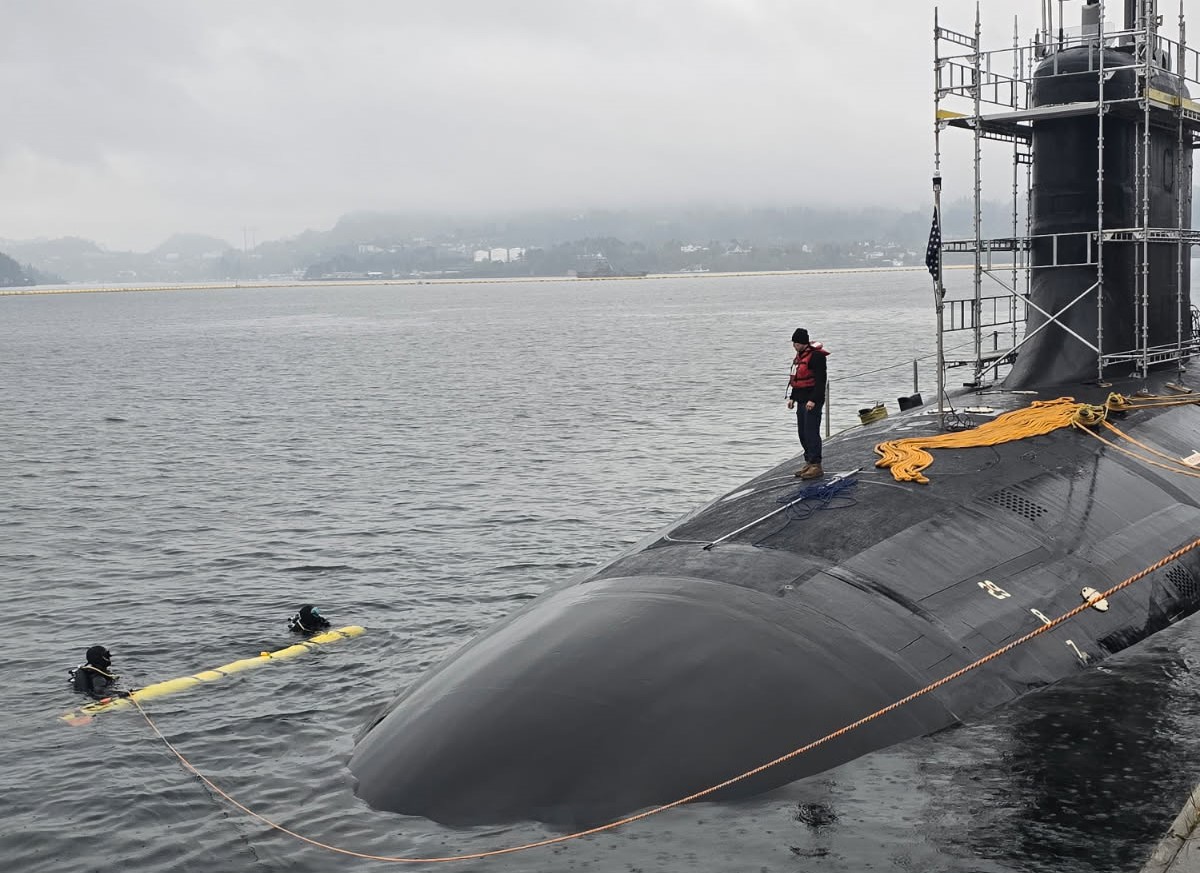Project Revolver has moved from lab study to fleet priority in less than three years. Senior officers at the Office of Naval Research (ONR) now describe the program as “an essential magazine-depth booster for fast-attack boats operating west of Guam.” Defense officials confirm that the latest engineering assessment, completed on July 6, cleared Revolver’s Multi-Vehicle Torpedo Tube Defense System (MVTTDS) for first-of-class sea trials with a Virginia-class submarine before the end of this quarter.
Unlike earlier attempts to squeeze more ordnance into a 21-inch tube, Revolver employs a plug-in launcher kit rather than a permanent hull change. Crews load the device in the same way they would load a heavyweight torpedo. When firing, the kit spins a “drum” of weapons forward, presenting each round to the ejector in sequence. ONR engineers say the system can cycle twelve Mark 58 Compact Rapid Attack Weapons (CRAW) in under ninety seconds.
Compact Torpedo Launcher Kit Redefines Undersea Payload Flexibility
Why the rush? U.S. Indo-Pacific Command told Naval Sea Systems Command last year that submarines assigned to deterrence patrols risk running empty before their missions end. In a region where surface combatants travel in dense, missile-defended groups, submarines cannot surface to reload. Extra tubes would help, but real estate on a 7,800-ton hull is fixed. Revolver sidesteps the space problem by stacking smaller torpedoes inside one tube, giving each boat a deeper “ready rack” without a yard period.
Key design points of the CRAW round:
- Caliber: 6.75 inches
- Length: 85 inches
- Weight: under 220 pounds
- Roles: anti-submarine, anti-torpedo, surface-attack in littoral waters
- Launch options: standard 21-inch tubes, countermeasure tubes, future vertical launch insert
Mark 58 CRAW Torpedo Targets Low-Cost Massed Engagements
The current Mark 48 heavyweight costs roughly $3.6 million per shot. CRAW aims for a tenth of that figure once Technology Insertion 2 (TI-2) reaches rate production. ONR hopes lower cost will encourage larger salvos against lower-value targets, conserving heavyweights for priority kills. Penn State University Applied Research Laboratory heads TI-1, which modifies the Anti-Torpedo Torpedo Defense System (ATTDS) body for early operational use by FY 2026. Raytheon leads TI-2 to improve manufacturability and add surface-ship hard-kill features.
Fleet feedback steers the schedule. Recent developments in submarine technology, such as General Dynamics’ $882 million contract for large vertical sonar arrays, also influence integration timelines and operational planning. A prototype Revolver unit shot twelve inert CRAW rounds from an instrumented barge in late 2024. Data showed acceptable dispersion and no tube-wall damage. Next up is a submerged shoot from a Block IV Virginia boat in Hawaiian ranges. If results mirror barge numbers, Pacific Fleet intends to fit one boat per squadron with the system as an “adaptive payload module.
Virginia-Class Integration Unlocks Higher Magazine Capacity
General Dynamics Electric Boat secured a $1.85 billion contract modification on July 2 for long-lead materials tied to submarine production and weapons-integration kits, including structural inserts for Revolver. According to company officials, the extra funding lets suppliers start machining release rack assemblies and shock mounts before the production decision this fall.
Three advantages once Revolver is fleet-wide:
- Salvo flexibility. One tube can fire heavyweight weapons, reload with CRAW clusters, then fire again without tools.
- Mixed loadouts. The same drum can carry 6.75-inch torpedoes, 3-inch expendable decoys, or unmanned aerial vehicles (UAVs) for over-the-horizon reconnaissance. Program managers say decoy-loaded drums allow boats to launch false targets in a spread that mimics a submarine’s escape turn.
- Magazine depth. A Virginia-class boat now embarks roughly 26 torpedoes or missiles. With three Revolver kits loaded, the count climbs above 50 without giving up Tomahawk strike cells.
Revolver’s architecture rests on a “loader-reloader” pair. The loader – installed in the torpedo room – extends a cantilevered arm that slides a packed drum into the open breech. After firing, the reloader draws the empty cassette back, aligns fresh rounds, and re-seats. Crew qualification videos show a two-sailor team completing the swap in four minutes while underway.
Development follows a spiral path familiar to submarine combat-system updates. Phase One focuses on manual reloads and single-shot control through the existing Weapon Control Console. Phase Two links the drum’s internal sensors to the ship data bus, allowing the fire control system to sequence shots automatically. Phase Three adds remote health monitoring so a force commander can query drum inventory across the task group.
CRAW-Torpedo Family Expands Across Sub and Surface Fleets
Linkages to the Nixie 25E hard-kill project amplify Revolver’s relevance. Starting FY 2026, carriers and destroyers will deck-launch an ATT-variant CRAW with the same seeker and warhead. Program leaders want one family of small torpedoes that surface ships shoot upward and submarines shoot forward. Shared sustainment chains cut life-cycle costs and speed software updates.
From a war-planning angle, Indo-Pacific Command sees Revolver as a tool for massed firings against large amphibious groups in archipelagic chokepoints. Smaller torpedoes travel slower than heavyweights but can saturate close-in defenses. A salvo of a dozen CRAWs forces targets to maneuver, exposing flanks to heavyweight follow-up. During a classified fleet problem last spring, exercise controllers credited a single Virginia crew with “mission kill” results on three simulated landing ships after launching 18 CRAWs in two minutes.
Reliability concerns still remain. Lightweight bodies tolerate less torsional stress, and ocean swell during tube loading can jar electronics. NUWC Newport’s materials branch is testing vibration-dampening rails and a shock-isolating collar added in Reloader Generation 2. That collar – now in machining – uses stacked ceramic disks to absorb axial loads, preventing tail-cone cracking. Bench tests show a 40 percent reduction in peak stress.
Budgeting stays modest by submarine standards. The FY 2026 RDT&E line requests just under $42 million for Revolver engineering and $24 million for CRAW software builds APB-1 and APB-2. Officials argue that the payoff comes in deferred overhaul time; more shots per patrol mean fewer underway replenishments and shorter pier-side torpedo reloads.
Lightweight CRAW Packaging Simplifies Submarine Logistics
Six CRAWs nest inside a carbon-fiber canister roughly the size of a Mark 48. Shipyard cranes need no new rigs, and storage racks accept the canister shape. That simplicity matters when forward-deployed tenders have limited deck space. The lightweight CRAW packaging approach underscores the system’s logistical advantages in the Indo-Pacific.
Questions about exportability cropped up during a Senate hearing in April. Lawmakers asked whether allies could field the system without revealing Re-entry Vehicle (RV) data linked to advanced sensors. Navy acquisition chiefs answered that CRAW’s seeker is ITAR-controlled; however, the mechanical drum and loader present no classified barriers. Partner navies with compatible tubes – Australia’s future SSN-AUKUS hull, for instance – could adopt the magazine hardware and fit a national small-torpedo round.
Program timeline:
- 2024: Prototype drum test at Naval Surface Warfare Center, Carderock.
- Q3 FY 2025: First at-sea firing from a Virginia-class submarine.
- Q4 FY 2025: Production-representative design contract under PMS-415.
- FY 2026: Integration trial with 3-inch UAV dispenser and acoustic decoys.
- FY 2027-2028: Lot 1 low-rate initial production, two drums per hull in Pacific Fleet.
- FY 2030: Full-rate production decision; baseline loadout set at three drums per boat.
Our analysis shows that the main schedule risk lies in software de-confliction between CRAW’s seeker code and the Virginia Attack Center’s existing torpedo stack. Navy labs run both codes today but inside separate sandboxes. Merging them will demand careful version control. A second risk is industrial surge. Drum fabrication uses wound-carbon barrels similar to missile canisters, and capacity for that sub-sector is tight.
Even so, fleet operators continue to push. A Pacific-based boat commander told reporters after a recent port call, “One Revolver kit means I can fight longer before rearm time. That matters more than headline range right now.” According to industry sources, his comments echo a wider chorus among commanding officers who see CRAW as a “use-first” weapon – cheap enough to expend yet lethal against diesel-electrics and small combatants.
Revolver may also force changes in tactics. Heavyweight torpedoes carry large warheads to crack ballistic-missile subs and major surface combatants. Smaller targets – patrol craft, unmanned surface drones, supply ships – do not justify such mass. A mixed locker lets commanders conserve heavy shots while removing secondary threats quickly. That flexibility undergirds emerging “distributed undersea operations,” where small wolfpacks shadow logistic routes rather than hunt carrier groups.
Evolving Submarine Tactics with Low-Cost Lethal Torpedo Options
Surface-ship integration remains a longer-term goal. Designers are studying a topside Rotary Launcher Module that could sit under the flight deck of amphibious assault ships. The idea mirrors the Reload Drum but flips vertical. If successful, an LHA could carry dozens of anti-torpedo interceptors without losing aviation fuel space.
Looking farther out, ONR teams are testing a 9-inch “stretch” version of CRAW with a fiber-optic link for real-time control. The wider body would cut the count per drum in half but extend range past 25 nautical miles and allow mid-course aim updates. Early pool firings at Lake Pend Oreille show promising stability, though guidance packages still overflow the fairing limits.
Every acquisition milestone so far has arrived on or ahead of plan; yet program leaders caution that success depends on clear requirements. They intend to lock the drum’s physical envelope before adding new payload types. That discipline prevents “requirement creep,” a common torpedo-program pitfall.
In the end, Revolver’s value rests on one fact: underwater weapons remain hard to replenish at sea. If a submarine can carry double the rounds without stretching the hull, it gains time, options, and leverage. For commanders balancing long patrols against deep target lists, that extra margin may spell the difference between staying on station and heading home early.
REFERENCE SOURCES
- https://www.armyupress.army.mil/Journals/Military-Review/English-Edition-Archives/May-June-2025/Rethinking-Retreat/
- https://www.navalnews.com/naval-news/2025/07/u-s-navy-multi-packing-cutting-edge-torpedoes-for-magazine-depth-in-the-indo-pacific/
- https://news.ssbcrack.com/u-s-navy-advances-multi-vehicle-torpedo-tube-defense-system-for-virginia-class-submarines/
- https://www.navalnews.com/naval-news/2025/07/u-s-navy-sets-sights-on-fleet-wide-anti-torpedo-weapon-rollout-in-coming-years/
- https://chuckhillscgblog.net/2025/07/06/u-s-navy-sets-sights-on-fleet-wide-anti-torpedo-weapon-rollout-in-coming-years-naval-news/
- https://www.thedrive.com/the-war-zone/33606/northrop-grumman-reveals-new-mini-torpedo-aimed-at-arming-and-defending-navy-submarines
- https://thedefensepost.com/2025/03/19/us-navy-northrop-undersea/
- https://militaryembedded.com/unmanned/sensors/autonomous-undersea-program-advances-with-navy-contract
- https://seapowermagazine.org/small-torpedo-being-prototyped-by-raytheon-to-arm-the-navys-submarines/
- https://seapowermagazine.org/northrop-grumman-preparing-response-to-rfp-for-navys-very-light-weight-torpedo-program/
- https://seapowermagazine.org/navy-down-select-for-compact-rapid-attack-weapon-expected-in-february/
- https://www.armed-services.senate.gov/imo/media/doc/4102025fulltranscript.pdf
- https://theasialive.com/us-navy-enhances-undersea-warfare-capabilities-as-new-block-iv-virginia-class-submarine-uss-arkansas-joins-fleet/2025/07/04/



